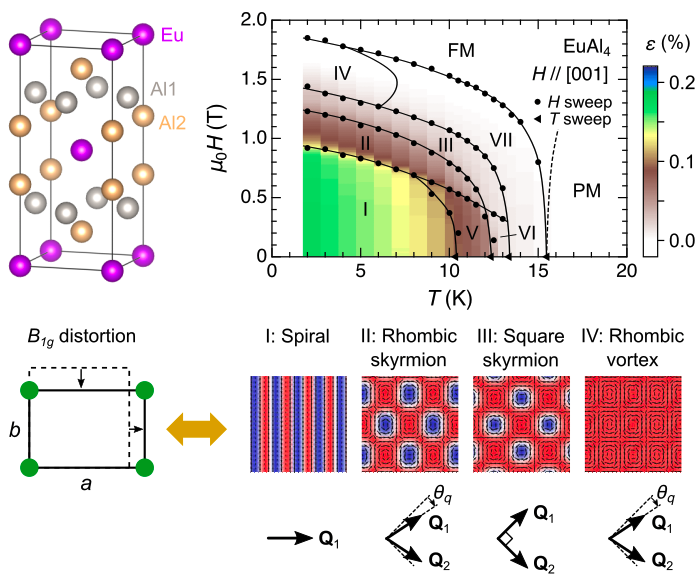Orthorhombic distortion and uniaxial-stress control of the magnetic phase diagram in a skyrmion-host tetragonal itinerant magnet
In bulk materials, skyrmion-lattice phases have conventionally been regarded as emerging in high-symmetry geometries such as triangular or square lattices. However, a skyrmion lattice with spontaneously broken rotational symmetry was first discovered in the itinerant magnet EuAl4 (space group I4/mmm). In this compound, magnetism is considered to be governed by the RKKY interaction among the localized spins of divalent Eu ions, giving rise to an intricate magnetic phase diagram. At zero field, a transition from the meron–antimeron lattice (phase VI) to a spiral phase (phase V) is accompanied by a tetragona-to-orthorhombic structural transition. When a magnetic field is applied along the c axis, low-symmetry multi-Q phases such as a rhombic skyrmion lattice (phase II) and a rhombic vortex lattice phases (phase IV) emerges in addition to a square-lattice skyrmion phase (phase III). The broken rotational symmetry of these spin textures points to strong spin-lattice coupling.
Here, we investigated the evolution of orthorhombic distortion accross the field-induced phase transitions in EuAl4 [A]. In the spiral phase (phase I) at zero field and 5 K, an in-plane orthorhombic distortion amounts to as large as 0.2%. Upon increasing the magnetic field, magnetostriction measurements using the fiber Bragg grating (FBG) method reveal that the magnitude of the orthorhombic distortion is gradually supprssed toward the forced ferromagnetic phase, accompanied by a sudden change at each magnetic transition. By simultaneously monitoring fundamental and magnetic reflections in resonant X-ray scattering, we unveiled the correspondence between the orthorhombic distortion and the magnetic modulation. These results provide information on the distance dependence of the magnetic interactions. In addition, a pronounced uniaxial-stress effect on the magnetic phase diagram of EuAl4 is anticipated, and we are currently conducting a collaborative study with the Nakajima Group (ISSP, UTokyo).
[B] M. Gen et al., to be submitted.
Here, we investigated the evolution of orthorhombic distortion accross the field-induced phase transitions in EuAl4 [A]. In the spiral phase (phase I) at zero field and 5 K, an in-plane orthorhombic distortion amounts to as large as 0.2%. Upon increasing the magnetic field, magnetostriction measurements using the fiber Bragg grating (FBG) method reveal that the magnitude of the orthorhombic distortion is gradually supprssed toward the forced ferromagnetic phase, accompanied by a sudden change at each magnetic transition. By simultaneously monitoring fundamental and magnetic reflections in resonant X-ray scattering, we unveiled the correspondence between the orthorhombic distortion and the magnetic modulation. These results provide information on the distance dependence of the magnetic interactions. In addition, a pronounced uniaxial-stress effect on the magnetic phase diagram of EuAl4 is anticipated, and we are currently conducting a collaborative study with the Nakajima Group (ISSP, UTokyo).
References
[A] M. Gen et al., Phys. Rev. B 107, L020410 (2023). (Original paper [19])[B] M. Gen et al., to be submitted.

